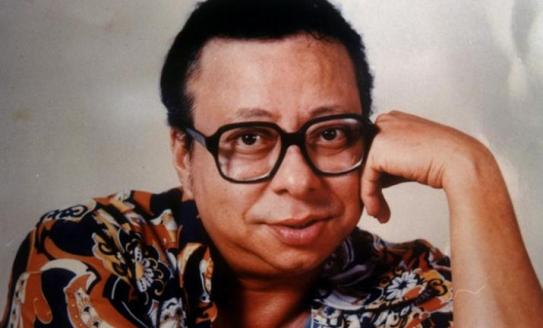 17th June, 2019
17th June, 201927th June marks R. D. Burman’s 80th birth anniversary. Radio, TV, print, and musicians who love his music, would surely be hosting tributes to the master craftsman, composer, versatile singer and actor showcasing the humorous as well as the misty eyed side of the great Panchamda.
No one can forget vintage classics like Pyar diwana hota hai, Tere bina zindagi se Chura liya hai tumne, Wada aro, Kya yehi pyar hai Tu tu hai wahi ,Bade achche lagate hain and Kya Hua Tera Vaada among many others. Pancham as he came to be known has belted out some of the jazziest hits in the history of Bollywood music.
We take a look at the life of R, D Burman.
Early Years
Rahul Dev Burman commonly known as R. D. Burman and nicknamed Pancham da or simply Pancham, was the only son of singer and Bollywood music composer Sachin Burman and Meera. Reports reveal that the word Pancham was tagged to him, for as a child whenever he cried, the sound filtered as Pa in the fifth note of the Indian musical scale. The word Pancham means five (or fifth) in Bengali and Sanskrit.
Born in Calcutta, Burman completed his schooling in Calcutta in West Bengal state and moved to Bombay where he learnt the sarod from legendary Ustad Ali Akbar Khan. He began his music career early and also learnt to play the mouth organ and assisted his father whenever he could. He composed his first tune Aye meri topi palat ke aa, which was used in ‘Funtoosh’ (1956).
Being with his father gave him an experience that took him forward, assisting his father for the movie ‘Chalti ka naam gaadi’ (1958) and ‘Kaagaz ke phool (1959). His musical brilliance took him forward for the song Sar jo tera chakraaye in Guru Dutt's film, Pyaasa’ a song he composed as a child. Years later he graduated to being a film music director in Guru Dutt’s ‘Raaz’ (1959). Gulzar recalls his friendship with Burman.“We were friends who, even if we met because of work, it never looked like we were meeting for work. We composed music casually, rather than writing and composing it.”
Pancham went on to do playback for eighteen movies, his famous grunting bass singing a trademark no one can copy. Pancham also chanced upon acting in two movies ‘Bhoot Bungla’ (1965) and ‘Pyar Ka Mausam’ (1967).
Since then, he has countless songs to his credit. As per records, out of the 331 movies he composed music for, 292 were in Hindi, 31 in Bangla, 3 in Telugu, 2 each in Tamil & Oriya and 1 in Marathi. He also composed for TV Serials too.
Personal Life
On the personal front, Pancham tied the knot with Rita Patel in 1966, but the marriage soured and ended in divorce in 1971. He then married Asha Bhosle in 1980, beginning not only a life together, but a musical career forever. Together, they made great music, which cannot be erased easily. With the beautiful music also came a sad phase in his life when he was faced with financial difficulties, that he managed to pass through.
Music style
While Pancham is credited for bringing western music’s disco and rock n' roll to Hindi films, creating a brand of music so distinctly his own, with his style and technique which has been adapted by many of todays budding composers,.there have also been many references made that a few of Pancham’s songs were inspired by Western songs.
While he set the groove for memorable songs like the romantic ‘Raat Kali’ (Buddha mil gaya), the sexy cabaret and heavy breathing in ‘Piya tu ab toh aaja’ (Caravan), Pancham's banshee cries of ‘Monica o my darling’ in the song have been firmly placed in the public's mind. Then you also have the ultimate hippie anthem in ‘Dum Maro dum’ (Hare rama hare krishna), one of the most memorable songs where Burman actually sang ‘Mehbooba, Mehbooba’ (Sholay), a full snip from ‘Say You Love Me’ by Greek singer Demis Roussos.
Others that fall in line include Aao twist karein (Bhoot Bangla) a direct lift of Lets twist again by Chubby Checker. Elvis was also taken in the wings by Burman in Tera mujhse hai pehle ka naata koi (Aa gale lag ja) to be a copy of the song The yellow rose of Texas. You also had Bhali Bhali Si Ek Surat (from Buddha Mil Gaya) inspired by Harry Belafonte’s Jump in the Line. Swedish group ABBA’s Mamma Mia inspired the song Mil Gaya Humko Saathi Mil Gaya (from Hum Kisi Se Kum Nahin).
You also have other examples like Kahin karti hogi (Phir kab milogi) inspired by the Lonely Bull by Herb Albert and the Tijuana Brass band. There’s also Gloria Estefan’s massive hit Oye Mi Canto lifted into Mera kaha manoge (Gurudev) and last but not least Paul Anka’s The longest day made into Zindagi milke (Satte pe satta).
But that aside, Pancham often found new ways to make music sound different. He created percussion using at times a spoon against a glass, tables, desks, gargling sound, a bamboo whistle with a balloon and bottles filled with water at different levels to produce new sounds. Such was his creativity.
Infact, Pancham who is considered India's most popular composer of the 1960s also teamed up with singers like Kishore Kumar, Lata Mangeshkar and others and also collaborated with British singer Boy George. “RD had the intuitive knowledge about orchestration. I feel he was a genius at creating melodies like Kuch na kaho (1942: A Love Story) that are timeless and have a very universal appeal. As a person he was unaffected by his popularity and greatness” states jazz keyboardist Louis Banks who considers Burman as his Godfather.
The winner of 3 Filmfare Best Music Director awards, he surely lives with us even today.
-- By Verus Ferreira
